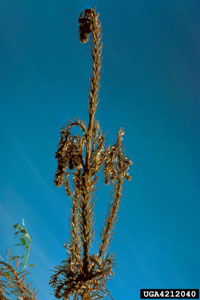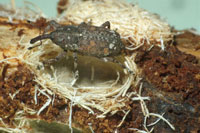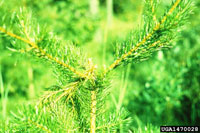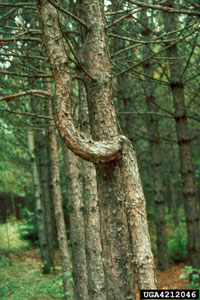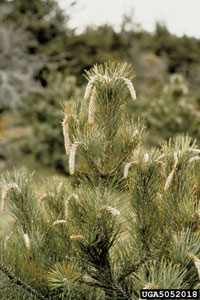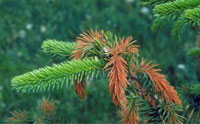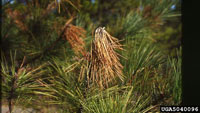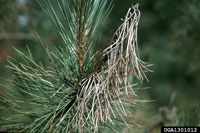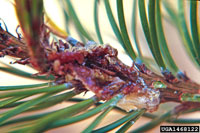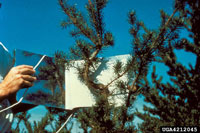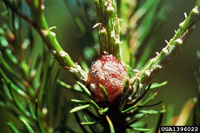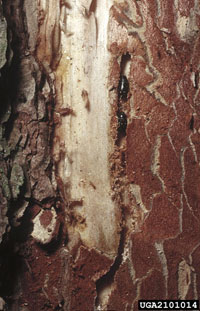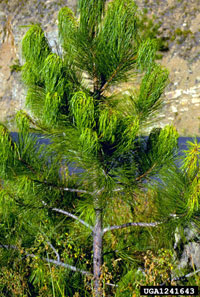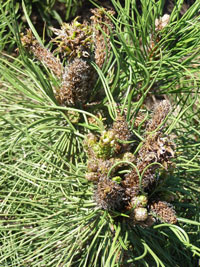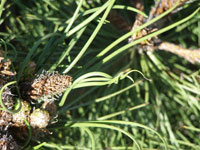Extension > Garden > Diagnose a problem > What's wrong with my plant? > Evergreen Trees and Shrubs > Pine > Wilted shoots
Pine > Shoots/Branch Tips > Wilted shoots
1 of 7
White pine weevil
Pissodes strobi
- Terminal leader dead or dying, curled into a shepherd's crook
- Branches in whorls near the top may also wilt and die
- Repeated attacks can leave trees looking bushy
- Drops of sap from feeding wounds on terminal shoots in early spring
- Prefers Eastern white pine but will also infest jack pine and Norway and blue spruce
- Small, ¼ inch long, white, grub-like larvae feed under bark from June to August
- Adult weevils ¼ inch long, dark with tan and white mottling; has conspicuous snout
- More information on White pine weevil
2 of 7
Eastern pine shoot borer
Eucosma gloriola
- Wilted or drooping shoots form a shepherd's crook which often break off
- Needles beyond feeding sites first turn yellow then reddish-brown
- Needles may drop prematurely
- Larva is off-white with dark head and grows to about ½ inch long
- Small, oval exit hole may be seen below dying shoot
- Prefers white and Scots pine
- More information on Eastern pine shoot borer
3 of 7
Frost injury
- New shoots fall over and wilt after a spring frost
- Older branches remain green and healthy
- Dead shoots may remain attached all summer, new shoots may grow next to them
- More information on Frost injury
4 of 7
Sirococcus shoot blight
Sirococcus conigenus
- Needles turn brown, wilt and droop
- Young shoots wilt and curl into a shepherd's crook
- Brown to black raised bumps can be seen on wilted needles and on shoots at the base of the needle in the fall or spring following the appearance of symptoms
- Older needles remain unaffected
- Common in cool, wet summers
- Infection often starts in the lower branches and moves up
- Common on red, jack and Scots pine; Austrian and eastern white pine are resistant
- Also infects spruce, fir and larch
- More information on Sirococcus shoot blight
5 of 7
Northern pitch twig moth
Retinia albicapitana
- Round, blister-like nodule less than 1 inch in diameter on twigs or small branch crotches
- Flagging, even dead or deformed branches, twig breakage can occur
- Most common on jack and Scots pine
- More information on Northern pitch twig moth
6 of 7
Pine shoot beetle
Tomicus piniperda
- Dying, dead and broken shoots, particularly in the top half of the tree
- Adults tunnel into shoots which turn yellow to reddish-brown
- Attacks most pine species where cut stumps or logs are present
- Adults are shiny, black and about the size of a match head
- Larvae are white with a brown head and about ¼ inch long
- More information on Pine shoot beetle
7 of 7
Growth regulator herbicide damage
(e.g. 2,4D or MCPP)
- Shoots may wilt or curl
- Needles stunted, twisted or misshapen but remain green
- If damage is severe, needles turn brown and fall off, branches may die
- Symptoms occur a few days to several weeks after herbicide application
- Dead or dying weeds expressing similar symptoms may be present nearby
- More information on Growth regulator herbicide damage



